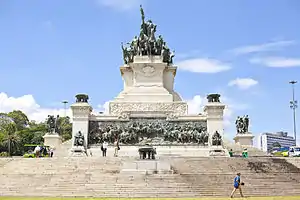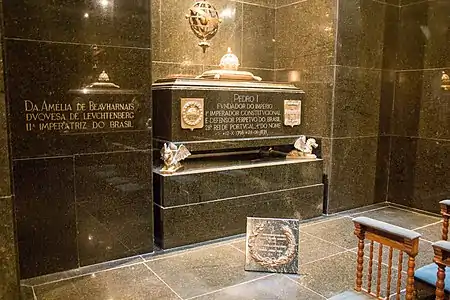Monument to the Independence of Brazil
The Monument to the Independence of Brazil (Portuguese: Monumento à Independência do Brasil) is a granite and bronze sculpture located in the Independence Park in São Paulo, Brazil. It is also known as the Ipiranga Monument (Portuguese: Monumento do Ipiranga) or the Altar of the Fatherland (Portuguese: Altar da Pátria). The monument is located on the banks of the Ipiranga Brook, on the historic site where Pedro, Prince Regent (later Emperor Pedro I) proclaimed the independence of the country on 7 September 1822.[1][2]
| Monument to the Independence of Brazil | |
|---|---|
| Native name Monumento à Independência do Brasil | |
 The monument is located where the Brazilian Independence was declared. | |
| Location | São Paulo, Brazil |
| Coordinates | 23°34′49″S 46°36′36″W |
| Established | 1952 |
| Founded | 1922 |
| Built | 1884–1926 |
| Architect | Manfredo Manfredi |
| Sculptor | Ettore Ximenes |
| Governing body | São Paulo |
The monument was designed and built by Italian sculptor Ettore Ximenes (1855–1926) and Italian architect Manfredo Manfredi (1859–1927) to celebrate the first centenary of the Brazilian Independence.
The crypt
An Imperial Crypt and Chapel is located inside the monument. The crypt was built in 1972 to house the remains of Emperor Pedro I (also King of Portugal as Pedro IV) and his wives, Maria Leopoldina of Austria and Amélie of Leuchtenberg. The crypt is consecrated as a Catholic chapel, as demanded by the then head of the Brazilian Imperial Family, Pedro Henrique of Orléans-Braganza. He agreed to allow the transfer of the bodies of his ancestors to the monument on the condition that the place be consecrated as a Catholic place of burial, with a Catholic altar, where masses could be held. Pedro I and Amélie of Leuchtenberg's bodies were transferred from the Royal Pantheon of the House of Braganza in Lisbon; while Maria Leopoldina was moved from the Imperial Mausoleum of St Anthony's Convent in Rio de Janeiro.[3][1][2]
Gallery
 The monument in 1937
The monument in 1937 Sculpture representing the participants of the Minas Gerais Conspiracy of 1789
Sculpture representing the participants of the Minas Gerais Conspiracy of 1789 Sculpture representing the revolutionaries of the Pernambucan revolt of 1817
Sculpture representing the revolutionaries of the Pernambucan revolt of 1817.jpg.webp) The eternal flame
The eternal flame Front panel, with a derivative representation of Pedro Américo's 1888 painting Independence or Death.
Front panel, with a derivative representation of Pedro Américo's 1888 painting Independence or Death. Hipólito da Costa, the "father of the Brazilian press"
Hipólito da Costa, the "father of the Brazilian press" Joaquim Gonçalves Ledo, leader of the independence movement in Rio de Janeiro
Joaquim Gonçalves Ledo, leader of the independence movement in Rio de Janeiro José Bonifácio de Andrada e Silva, one of the founding fathers of the country
José Bonifácio de Andrada e Silva, one of the founding fathers of the country Diogo Antônio Feijó, regent of the Empire of Brazil
Diogo Antônio Feijó, regent of the Empire of Brazil Triumphal March of the Brazilian Nation
Triumphal March of the Brazilian Nation Sarcophagus of Pedro I
Sarcophagus of Pedro I View from Independence Park
View from Independence Park
References
- Moraes, Fábio Rodrigo de (2008). "Uma coleção de história em um museu de ciências naturais: o Museu Paulista de Hermann von Ihering". Anais do Museu Paulista: História e Cultura Material. 16 (1): 203–233. doi:10.1590/S0101-47142008000100006. ISSN 0101-4714.
- Oriá, Ricardo (2015). "Construindo o Panteão dos Heróis Nacionais: monumentos à República, rituais cívicos e o ensino de História". Revista História Hoje. 3 (6): 49–50. doi:10.20949/rhhj.v3i6.137. ISSN 1806-3993.
- "Monumento à Independência do Brasil foi restaurado". Gazeta da Mooca (in Portuguese). Sao Paulo, Brazil. 2016-11-16. Retrieved 2017-11-13.
External links
- Monument to the Independence of Brazil at the São Paulo City Museum Website (in Portuguese)
 Media related to Monumento à Independência do Brasil at Wikimedia Commons
Media related to Monumento à Independência do Brasil at Wikimedia Commons